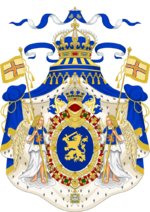Ultraroyalisten
| Ultraroyalisten | |
|---|---|

| |
| Leader | Pieter-Jan Hoogendijk |
| Founded | 1664 AN |
| Headquarters | 's Koningenwaarde |
| Political ideology | Imperialism, monarchism, reactionarism |
| Political position | Right-wing |
| Colours | Yellow |
| Parliamentary seats | 70 / 150 |
The Ultraroyalisten is a political party in Batavia. Their main goals are the defence of the monarchy as a powerful institution (especially in emergencies) with an even stronger aristocracy. It seeks to protect the rights of the landholders, industrialists, Catologian Church and nobility, while limiting the rights of the common man and worker. It doesn't seek the abolishment of the Lagerhuis, but promotes actions which keep the poorer classes from actively participating in the voting and parliamentary process. Despite its name choice, the strong support for the monarchy is merely an attempt to give the aristocratic regime some sense of legitimacy. The party members are therefore known to be anti-Vinandists, as a domestic king or queen would hold too much influence in government affairs.
des Vinandy-Windsor
In the 1668 Lagerhuis elections, it lost its absolute majority, but remained the second largest party with 70 of 150 seats. In the 1672 election it lost almost all its seats, with exception of two (as most Ultraroyalist had not gone to vote as a protest against the government).
Over the next couple of years, the party was reduced to a shadow of its former self. Despite - or because of - its loss in support among the voting class, the party started to distinguish itself from other parties by openly supporting the ascension of a Kalirion on the Throne. David Ayreon-Kalirion had long been their favourite candidate, but eventually a personal union between Batavia and Shireroth was advocated.
It was during the Batavian Revolution in 1685 AN that the party regained its prominence: the red wave which spread throughout the country led to the loss of the government's majority in the Lagerhuis. With no king on the Lion Throne and the successor having been evacuated out of fear for life, the Ultraroyalists succeeded in pushing Salome on the Throne as a stewardess.
Thuylemans
During the 1690's, Louis Thuylemans began replacing Joseph des Vinandy-Windsor - who, due to old age was retiring - as chairman of the party. In 1698 AN, he officially took the reins. Thuylemans, who had enjoyed the benefits of Shirerithian rule during his short-lived college days when Salome had become Staatsholder (1686–1691), was a staunch proponent of the Kalirionists.
However, at the same time, he started distancing himself from the idea of placing a foreigner on the Lion Throne. His good personal relations with Frederik Alfons des Vinandy brought in a fair share of Vinandists, who could find themselves in the ideals of a strong monarchy.
The Ultraroyalisten opposed the sale of the Brettish Isles to the Calbain by the Second Starck Administration in 1709 AN, which increased their popular support among the masses. The CMP faced significant backlash, ultimately leading to its defeat in the Lagerhuis elections. In an effort to restore trust in the administration, Joseph des Vinandy-Windsor was appointed as Prime Minister, becoming the first Ultraroyalist to hold the office and the one who led to the integration of Batavia into Shireroth under the Treaty of Raynor's Keep. Following his death from old age, Louis Thuylemans succeeded him as Prime Minister of Batavia in 1713 AN.
Hoogendijk
In 1718 AN, Louis Thuylemans was summoned to Shirekeep to take on the delicate task of maintaining balance within the fragile Shirerithian government. Tensions between the Western Imperium (Shireroth’s Benacian territories) and the Eastern Imperium (Greater Kildarian region) remained high, exacerbated by deep-seated distrust towards Humanists within the government. As a Batavian, Thuylemans was seen as a neutral power broker, a relative moderate with leadership experience, having governed Batavia for five years. His appointment helped resolve the political deadlock, as any attempt to install a Jing official would have sparked outrage within Shirekeep’s ruling circles.
Upon his departure, Thuylemans entrusted the leadership of his party and government to his protégé, the 29-year-old Pieter-Jan Hoogendijk, the Count of Beyssel ("Graaf van Beyssel"). A rising political figure, Hoogendijk was tasked with ensuring stability within Batavia, navigating a period of both internal consolidation and external pressures.
Under Hoogendijk’s leadership, the administration focused on a pragmatic balance between social appeasement and aristocratic consolidation. Recognizing the need to maintain public order, his government introduced minor social programs designed to prevent unrest and keep the masses compliant. However, his policies also significantly strengthened the power of local nobility, particularly within municipal governance and the provincial councils ("Gewestraden"), reinforcing a decentralized aristocratic structure.
One of Hoogendijk’s most notable achievements was the construction of the Batavian Waterline during the 1720s, a vast system of fortifications and flood defenses. Initially envisioned as a strategic buffer, the Waterline later proved vital in protecting Batavia’s most densely populated regions during the Shiro-Benacian War. His focus on defensive infrastructure reflected a long-term vision for Batavia’s security, ensuring that key urban centers could withstand potential conflicts with the Benacian Union. Despite his relative youth, Hoogendijk’s tenure marked a period of measured governance, where political stability was maintained through a mix of calculated reforms and traditional power structures.